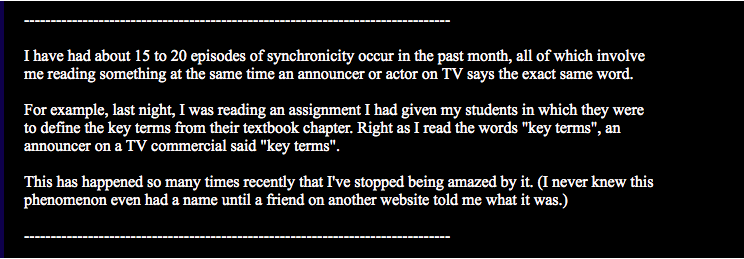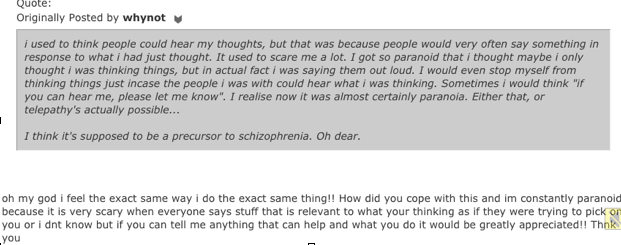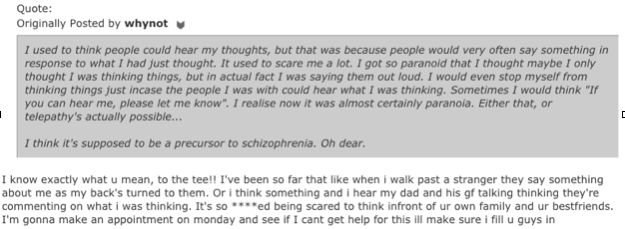This research material presents firsthand experiences of people who observed an unrecognized/unidentified phenomenon on Earth. This phenomenon gives false evidence supporting these delusions and can be recognized as synchronicities. The existence of these unique synchronicities goes back to the 17th/18th century. A researcher who critically analyzes these human experiences will understand that the cause behind these synchronicities is affecting the thoughts and actions of human beings in extremely complicated ways. Due to this nature, these unique synchronicities could easily make you believe that people know your thoughts, and they are indirectly referring to your thoughts and/or they indirectly talk about you. Therefore, these synchronicities are able to establish strongly held false beliefs in an observer's mind.
A Brief Introduction:
- In my main research material, I stated that I observed a phenomenon that was not known to humanity prior I end up concluding that people know my thoughts.
Source:
The Deceptive Nature Of Synchronicities Sheds Light Into The Gangstalking Phenomenon, Schizophrenia, And Our Delusions! – The Ultimate Disclosure Of the Man-Made Phenomena!
- I observed this phenomenon again and again, and it provided me false evidence supporting the view that "people know my thoughts." In other words, at times, people actually reacted to my thoughts within seconds, and these reactions gave me convincing evidence for me to conclude that "people know my thoughts." But then again, at times, after I was thinking something, I observed a meaningful event which correlated with my thoughts a few minutes, a few hours or a few days later. These events gave me convincing evidence for me to conclude that "people know my thoughts." I faced an extremely high number of such synchronistic events (sometimes more than 15 cases per day). Therefore, these events cannot be considered as mere coincidences. Human thoughts and actions are getting affected due to an unknown reason to humanity. However, this does not mean that people know your actual thoughts.
- Once I managed to correct my false conclusions (delusions), I carried out extensive research, there I came to know that human beings around the world have been observing the same phenomenon. And they also have ended up concluding that "people know my thoughts" by observing the phenomenon.
- Once the false belief which is "people know my thoughts" have been established in human minds, some of them also have ended up concluding that "my thoughts are broadcasting." I came to an understanding that they have made this conclusion by trying to understand their observations. (For example, if so many people know my thoughts, then my thoughts could be broadcasting.)
(Note that people who observe these synchronistic events will first start believing that people know my thoughts. Once this view is established in their minds, they would even claim that "my thoughts are broadcasting", "people could read my mind", "I'm a telepathic", "my mind is a transmitter of thoughts", I'm a psychic, I'm experiencing Artificial/Synthetic Telepathy developed by NSA/CIA/MI5, etc.)
- Therefore, these so-called unshakeable delusions are nothing more than erroneous conclusions.
- Dr. Carl Jung used the word "synchronicity" to explain meaningful coincidences/events in his book "Synchronicity: An acausal connecting principle." This phenomenon that human beings observe can be recognized as synchronicities or meaningful coincidences/events. Observing a high number of unique synchronicities is the cause behind these delusions.
- These synchronicities or meaningful coincidences/events can be recognized further as meaningful verbal and nonverbal events (synchronicities will fall under these two communication categories). The person who observes these meaningful verbal and nonverbal events will see clear correlations to his/her thoughts.
- Since these are independent events, but yet it occurs in such a way where the event will deliver a specific meaning to the observer(s), these events are synchronicities. For example: While you are thinking of a particular movie, your friend who is next to you start talking about the same movie.
Although the word synchronicity is used to explain meaningful coincidences or meaningful events, there's a huge difference between a true coincidence and a synchronicity or a synchronistic event. A true coincidence is an extremely rare event. However, synchronicities or synchronistic events are not rare. Sometimes you would experience 10, 15+ synchronicities during a day. Therefore, the driving force behind synchronistic events is not the same as true coincidences. When you experience such a high number of meaningful coincidences or meaningful events, then you would understand that you are facing synchronistic events and these are not true coincidences.
For example, this individual is facing synchronicities, and these are not true coincidences:

Source:
Original Synchronicity Stories 1
This strange phenomenon could happen with live TV/Radio presenters, TV/Radio commercials, or even with TV shows. Assume you are reading something and that has the word "key terms" in it. By the time you read that unique text, you hear live TV presenter uses the same word at the exact moment or just seconds after that, in his spoken words. This timing activity could happen with TV commercials. By the time you are about to read the word "key terms" in the sentence, the right TV commercial also gets aired which has the word "key terms" in its script. Then by the time you read the word, the TV commercial also gets aligned in such a way, where you will get to hear TV commercial saying "key terms" at the exact moment of just seconds after that. This same thing could happen with TV shows as well. When you analyze these events deeply, you will understand that your thoughts and actions are being affected mysteriously.
Further, according to Dr. Bernard's survey, the most frequent coincidence was:
- I think of an idea and hear or see it on the radio, TV or internet. (Out of 1500 people who has visited the site, 200 (13%) had taken the weird coincidence survey)
Source:
Weird Coincidence Survey Results - Connecting with Coincidence
(Dr. Bernard is a visiting professor at the University of Virginia and a former chair of the Department of Psychiatry at the University of Missouri-Colombia)
When it comes to the delusions mentioned in this research material, the following are examples of meaningful verbal and nonverbal events or synchronistic events that you would observe:
Verbal Events: Spoken words of a person(spoken words in a face to face conversation, TV/ Radio presenters speech, telephone conversations, etc.), written notes and emails, etc. An Individual would observe such an event by correlating to a thought that the individual had.
For example:
i). While you are thinking something, the person who stays next to you start talking about the same thing or would say something that would correlate with your thoughts.
ii). The person who is next to you would write something, and that will correlate with your thoughts, or you receive an email where its title or body would show correlations to your thought.
Nonverbal Events: Sudden Facial expressions (smiling, laughing, frowning, etc.), Sudden Gestures, Signs, Sudden Eye contacts, Sudden Behavioral changes, Paralinguistic events (ex: tone and loudness of spoken speech).
For example:
i). You got a negative thought in your mind about the person who is sitting next to you, and you observe that person suddenly look into your eyes and frown or move away from you.
ii). While you are thinking of something, the person who is next to you say something in a sarcastic (voice tone) manner or that person would suddenly smile or laugh, and you see a clear correlation to your thought.
How to understand if you are facing synchronicities and that your belief or conclusion is not true:
I). You will observe a high number of meaningful coincidences/events.
II). You will have to give so many references for your belief to another person when explaining the reasoning behind your conclusion. The medical community will consider these references as ideas of references and delusions of references.
III). These events can be recognized as meaningful verbal & nonverbal events. Most of the time, it would be like people are indirectly referring to your thoughts / life events.
IV). These observable events will make you believe that people know your thoughts / know you / know your life events.
V). So many people will reject your claims, accusations, or your beliefs.
VI). You will see that your conclusions are controversial yet these unusual events will still convince you.
VII). Certain events can even make you think that your government, police officers, people in streets, corporations, your family members, friends etc. are conspiring against you / harassing you on purpose or even monitoring you.
VIII). What you observe is not a normal human experience.
IX). The medical community has recognized your claim as a delusion.
If your experience shows the above characteristics, what you are observing is synchronicities. People are not aware of your thoughts. Neither your thoughts are broadcasting. The cause behind synchronicities is actually affecting human thoughts and actions, and it will create meaningful events. These meaningful events would correlate with your thoughts. Therefore, these events will give you false evidence to make you believe that people know your thoughts. But in reality, your thoughts are not known by others, so they would reject your claim.
These synchronicities or verbal and nonverbal events that correlate with our thoughts are being observed by people around the world who have these delusions. These so-called unshakeable delusions are nothing more than erroneous conclusions made by the observers of the phenomenon.
To understand the below human experiences, you may assume that your thoughts are actually broadcasting.
I). If so, do you think people would laugh at your thoughts? Will they smile? Will they get angry and show an angry face? Will they move away from you? Will they show a surprising look just because you had such a thought? - All these are meaningful nonverbal events or synchronicities that you would observe if your thoughts are actually broadcasting.
II). Will they say something meaningful in replying to your thoughts? Will they repeat what you just thought? These are meaningful verbal events or synchronicities that you would observe if your thoughts are actually broadcasting.
(By using the words "Synchronistic Events / Synchronicities" this material would refer to such meaningful verbal and nonverbal events. The observer will see these events always correlating to his/her thoughts when it occurs.)
Human beings who claim that people know my thoughts/ my thoughts are broadcasting is observing a high number of such synchronistic events. This is what empirical observers of the phenomenon have to say:
Case Study 1). This individual states:
I). "I used to think people could hear my thoughts, but that was because people would very often say something in response to what I had just thought. It used to scare me a lot." In other words, he/she observes human beings reacting to his/her thoughts in such a way where these reactions always show meaningful correlations to his/her thoughts; therefore, these are synchronistic events. A high number of synchronistic events as such has provided her false evidence supporting the false view that "people know my thoughts."

(As mentioned earlier, assume your thoughts are actually broadcasting, if so what kind of possible reactions that you would observe from people? This line of thinking will help a researcher to understand these unusual experiences. Due to an unknown reason to humanity, only certain people in the world are facing these experiences. Therefore, it's hard to understand this phenomenon, if you have never experienced it. This is not an imagination & this is not a mental illness.)
Source:
Worry about people reading my mind - Social Anxiety Forum
Case Study 2).
I). "it is very scary when everyone says stuff that is relevant to what your thinking." Meaning, the spoken words of people have correlated with his/her own thoughts. Even for this individual, these synchronistic events have been providing false evidence supporting the false belief, which is "people know my thoughts."

Source:
Worry about people reading my mind - Page 2 - Social Anxiety Forum
Case Study 3).
I). "Oh I think something and I hear my dad and his gf talking thinking they're commenting on what I was thinking". - The spoken words of Dad and his girlfriend has correlated with this individual's thoughts. Observing a high number of such synchronistic events is the cause behind the belief, which is "people know my thoughts."
 Case Study 4).
Case Study 4).
I). "We've excluded coincidence, like driving past a yellow signpost and both mentioning yellow" - Which is a meaningful verbal event or a synchronicity.
II). "a new gym instructor. I told her I had spinal fractures and was thinking about the accident when I told her. She said "from falling of a horse?" - While she was thinking about her accident, the gym instructor mentions what she was thinking just like she knew her thoughts. Which is again a meaningful verbal event or a synchronicity.
III). She further states that "I nodded, she (gym instructor) said "you look like a horse person." The gym instructor was giving references to the thoughts once again. Therefore, these are meaningful verbal events or synchronistic events.
IV). She mentions this odd event to her husband, and she says: "Anyway I got home and started to tell my husband. I told him she said, "from falling off a horse" to which he replied "she said you look like a horse rider! Huh? I was stumped." Which is another meaningful verbal event or a synchronicity, since she already heard these words from her gym instructor and now husband is referring to her thoughts/earlier events.

Source:
https://www.socialanxietysupport.com...06/index3.html
Case Study 5).
I). "she actually looked at me when I was getting intrusive thoughts or thinking about her reading my mind"- She is referencing to a meaningful nonverbal event or a synchronicity that she observed. If you experience these events, it will quickly grab your attention since these events keep recurring. Therefore, it is not that people are finding patterns that are not there, people are stating what they observe and coming to a conclusion based on what they observe. By making false assumptions, they have ended up in false conclusions which we see as delusions.

Source:
https://www.socialanxietysupport.com...06/index6.html
Source:
https://theultimatedisclosure.com/20...be-recognized/